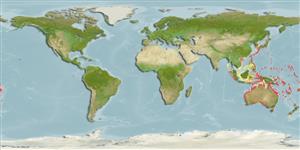Environment: milieu / climate zone / depth range / distribution range
Ecología
marino asociado a arrecife; rango de profundidad 3 - 30 m (Ref. 86942), usually 3 - 4 m (Ref. 90102). Tropical
Distribución
Países | Áreas FAO | Ecosistemas | Ocurrencias, apariciones | Point map | Introducciones | Faunafri
Western Pacific: Australia (known only from Rottnest Island and Shark Bay in Western Australia and One Tree Islands, in the Capricorn Group of the southern Great Barrier Reef). Recently reported from the Chesterfield Islands (Ref. 13236).
Tamaño / Peso / Age
Maturity: Lm ? range ? - ? cm
Max length : 5.0 cm TL macho / no sexado; (Ref. 2334)
Short description
Morfología | Morfometría
Espinas dorsales (total): 12; Radios blandos dorsales (total): 9; Espinas anales 2; Radios blandos anales: 8. Body scales form expanded spinous points; each scale forms a blade-like ridge (Ref. 39602).
Occurs in rocky reefs and soft-bottom trawling grounds. Also found in sand and rubble bottoms, usually near reefs in 3-4 m (Ref 90102). Minimum depth from Ref. 090102.
Life cycle and mating behavior
Madurez | Reproducción | Puesta | Huevos | Fecundidad | Larva
Randall, J.E., G.R. Allen and R.C. Steene, 1990. Fishes of the Great Barrier Reef and Coral Sea. University of Hawaii Press, Honolulu, Hawaii. 506 p. (Ref. 2334)
IUCN Red List Status (Ref. 130435)
Threat to humans
Harmless
Human uses
Más información
Nombres comunesSinónimosMetabolismoDespredadoresEcotoxicologíaReproducciónMadurezPuestaAgregación para la puestaFecundidadHuevosEgg development
Age/SizeCrecimientoLength-weightLength-lengthLength-frequenciesMorfometríaMorfologíaLarvaDinámica larvariaReclutamientoAbundanciaBRUVS
ReferenciasAcuiculturaPerfil de acuiculturaRazasGenéticaElectrophoresesheritabilidadEnfermedadesProcesamientoNutrientsMass conversion
ColaboradoresImágenesStamps, Coins Misc.SonidosCiguateraVelocidadTipo de nataciónSuperficie branquialOtolitosCerebrosVisión
Herramientas
Special reports
Download XML
Fuentes de Internet
Estimates based on models
Preferred temperature (Ref.
123201): 15.5 - 29.3, mean 27.4 °C (based on 1659 cells).
Phylogenetic diversity index (Ref.
82804): PD
50 = 1.0000 [Uniqueness, from 0.5 = low to 2.0 = high].
Bayesian length-weight: a=0.01995 (0.00906 - 0.04395), b=3.01 (2.83 - 3.19), in cm total length, based on all LWR estimates for this body shape (Ref.
93245).
Nivel trófico (Ref.
69278): 3.2 ±0.5 se; based on size and trophs of closest relatives
Fishing Vulnerability (Ref.
59153): Low vulnerability (10 of 100).
